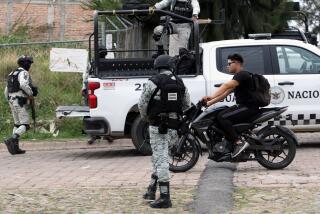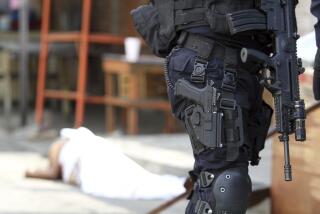Find Adds a Clue to Teotihuacan Riddle
- Share via
A newly opened tomb in Mexico’s Pyramid of the Moon has revealed a grisly sacrificial burial that highlights two contradictory aspects of the mysterious Teotihuacan culture -- the decapitation of 10 people and the presence of exquisite artworks unlike any previously discovered in the region.
The findings from the ancient “City of the Gods” about 30 miles northeast of Mexico City reinforce the growing idea that the Teotihuacanos were a warlike people, not the gentle, pastoral folk they were once thought to be, archeologists said this week.
Larger and more impressive than any of the tombs previously found in the pyramid, the newly discovered chamber indicates that the pyramid was significant to the Teotihuacanos as a site for celebrating the power of the state through ceremony and sacrifice, said archeologist Saburo Sugiyama, who led the excavation.
The chamber contained the remains of 12 people, all apparently sacrificed, together with a variety of offerings and the remains of different animals.
Ten of the people had their hands tied behind their backs and were decapitated before their bodies were thrown in a pile on one side of the chamber. The others also had their hands tied but were not decapitated and were “richly ornamented” with greenstone ear spools and beads, a necklace made of imitation human jaws, and other objects indicating high rank.
“We don’t know who the victims were, but we know that this ritual was carried out during the enlargement process of a major monument,” which indicates it was a very important event, said Sugiyama, of Aichi Prefectural University in Japan and Arizona State University.
The sacrifices may have “created a horrible scene of bloodshed,” he said. The ritual “must have been one of the most terrifying acts recorded archeologically in Mesoamerica.”
Also found in the tomb was a greenstone mosaic figure “unlike anything that has ever been found before in Teotihuacan,” said archeologist George Cowgill of Arizona State. “It’s really not all that similar to anything else from Mesoamerica.”
The figurine is made of serpentine and jade that are not of local origin. It was found in an unusual “offering” at the center of the burial chamber.
It was surrounded by 18 large obsidian knives, half of them in the shape of feathered serpents. Each was about 1 1/2 feet long, thin and delicately worked. “It is a staggering achievement to take such a large piece of obsidian, which is basically volcanic glass, and work it so finely,” Cowgill said. The feathered serpent is a symbol of maximum political authority, Sugiyama said.
The animal remains were found on the sides of the tomb, especially on the end opposite the decapitated bodies. They include five wolf or coyote skeletons, three puma or jaguar skeletons and the remains of 13 birds, at least one of them an eagle.
All of the animals are believed to be symbols of warriors in Teotihuacan culture. Many of the animals apparently were bound. Numerous other animal skulls were present.
The burial also contained obsidian human figures, knives, projectile points, shell pendants and beads, ceramics, plaques and a large disk.
Teotihuacan, called the City of the Gods by the Aztecs, who discovered it in the 15th century, eight centuries after it had been abandoned, was initially settled in the 1st century BC by a people of unknown origin.
At its peak, it covered 8 square miles and had a population of 150,000 people.
Archeologists cannot read the Teotihuacanos’ writing, if it is writing. They don’t know who built the city, what they called themselves, how they spread their control over much of Mesoamerica, or why they abruptly disappeared in the 7th century.
Images throughout the city show animals, plants, commoners and gods, which led archeologists to initially believe that the Teotihuacanos were a peaceful people. But excavation over the last two decades by Sugiyama, Cowgill and others revealed that many tombs contained sacrificed soldiers and captives, indicating the society may have been warlike.
The Pyramid of the Moon is the largest structure in the city and is known to have been built in seven phases. The new tomb was built during the fifth phase, when the city was at the height of its power.
Sugiyama’s co-investigator was archeologist Ruben Cabrera of Mexico’s National Institute of Anthropology and History. Their work was supported in part by the National Geographic Society and will be reported in its magazine next year.
More to Read
Sign up for Essential California
The most important California stories and recommendations in your inbox every morning.
You may occasionally receive promotional content from the Los Angeles Times.








